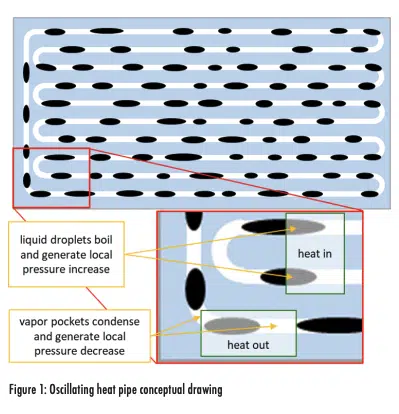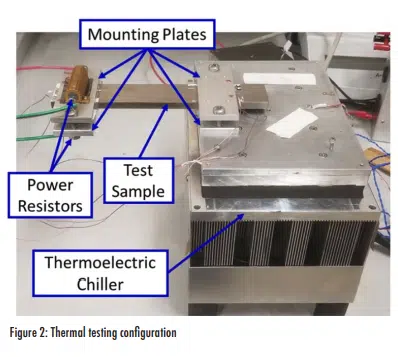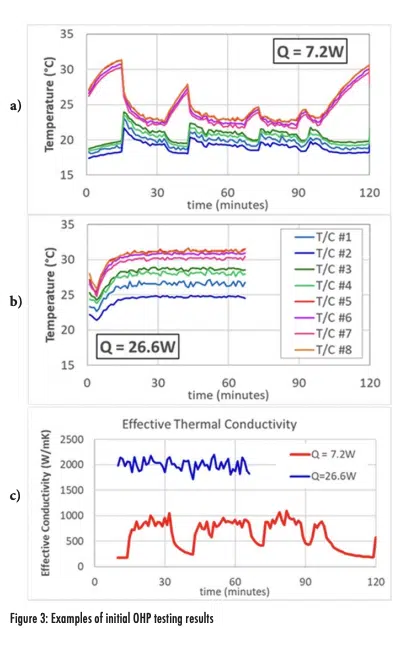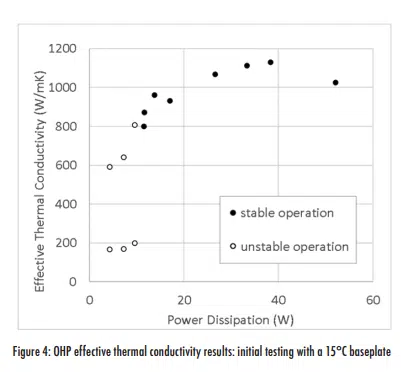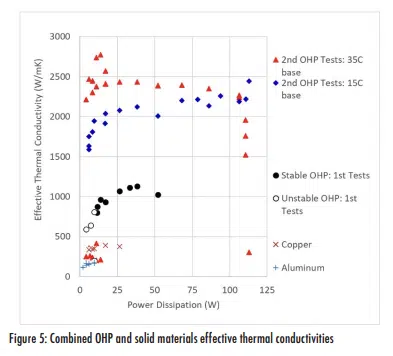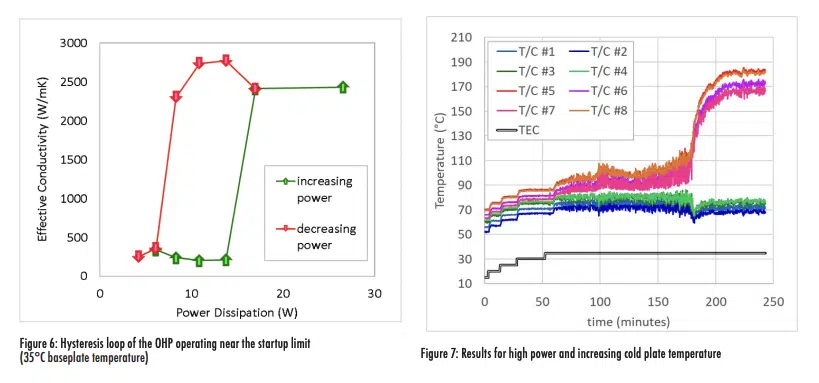A heat pipe is a closed system that contains a saturated fluid. When heat is dissipated in one region of the heat pipe, liquid in that area boils or evaporates, which produces vapor that moves to another area in the heat pipe where it condenses. The condensed liquid then returns to its starting point to transport energy from the heat input region(s) to the heat output region(s). The primary difference between different heat pipe technologies is the mechanism by which condensed liquid returns to the heat input regions. For example, conventional heat pipes have a wick that promotes liquid flow through surface tension. Thermal siphons rely on gravity, so their operation is greatly impacted by their orientation.
Oscillating heat pipes (OHPs), also known as Pulsating Heat Pipe (PHPs), have serpentine channels that contain the saturated fluid in discrete droplets of liquid that are randomly interspersed between pockets of vapor. Figure 1 conceptually shows an OHP with a close-up view of a region of the OHP in which areas of heat input and output are indicated. Dark bubbles represent liquid droplets while white regions represent vapor pockets. Energy absorbed in the ‘heat in’ region, cause liquid droplets there to evaporate and become vapor. Likewise, the vapor condenses in regions where energy is removed, i.e., ‘heat out’ areas. These processes generate local pressure variations that cause the liquid droplets and vapor pockets to move – thereby bringing liquid into the heated regions and vapor into the cooled regions. The random distribution of liquid and vapor droplets/pockets within the serpentine path create local fluctuations in pressures, in space and time, leading to random oscillatory flow within the OHP.
Because they rely on non-linear phenomena such as two-phase heat transfer, surface tension, etc., OHPs can exhibit non-linear behavior under different temperature and power conditions. With a proper design that accounts for the coupled effects of fluid properties and flow geometries, OHPs can stably operate over a range of conditions. Factors that influence that stable operating range include gravity, vapor inertia to overcome liquid surface tension, heat flux, sonic flow, fluid properties including viscosity and wetting angle, and device-specific factors such as fluid fill-fraction and evaporator/condenser lengths [1].
Many publications, including Electronics Cooling Magazine [2, 3], have discussed oscillating heat pipes. This article specifically focuses on measurements of the effective thermal conductivity of an OHP and evaluates stability conditions that define its functional operating range, as reported in Ref. [4].
This article describes testing with an OHP that was 15.24 x 2.08 x 0.40 cm (6 x 2 x 0.156 inches), made of aluminum, and filled with ammonia. Baseline testing was also done on similarly sized aluminum and copper bars, to validate the approach used to determine effective thermal conductivity.
Figure 2 shows the test configuration used for evaluating the samples. Mounting plates were attached to each end of the test bars and the OHP. These mounting plates included type T thermocouples to monitor temperatures. One end of the test sample was attached to a thermoelectric chiller that maintained the temperature of that end of the test sample. Power resistors were attached to the mounting plates fixed to the other end of the test sample to provide input power. The heaters, test sample, and thermoelectric baseplate were insulated during the tests.
Testing was conducted by setting the thermoelectric chiller temperature to a fixed value (typically 15°C), applying a constant voltage to the heaters, and then collecting temperature data after the system had stabilized for 30-60 minutes. Data included temperatures from the thermocouples as well as the current (I) and voltage (V) from the DC power supply.
The effective thermal conductivity of a material was determined using the one-dimensional thermal conduction equation and rearranging terms to be:
The geometric parameters t and W were fixed by the geometry of a given test sample. The length L depended on the test setup in that it was the distance between the inner edges of the two mounting plates. These plates were oriented such that the thermocouple junctions were located at these edges. Validation testing with the 7075 aluminum and copper test bars found effective thermal conductivities of ~170 and ~380 W/mK respectively. These compare well with published values for the metals, indicating that the test approach was reasonable.
Figure 3 shows plots of temperature measurements of the OHP over time for initial testing at different power dissipation values (Q) of 7.2 and 26.6W. Blue and green lines indicate temperatures of the mounting plates attached to the thermoelectric chiller while red and orange lines correspond to temperatures on the heater plates. The temperature difference (ΔT) is the average of the four heater plate temperatures minus the average temperature of the thermocouples on the mounting plate attached to the thermoelectric chiller. Figure 3 shows substantially different behavior in that the OHP did not operate stably at the lower power of 7.2W, Figure 3a), but was stable when operated at the higher power of 26.6W, Figure 3b). The unstable operation at low heat input is due to non-linear relationships between boiling initiation, temperature-dependent surface tension, etc. and demonstrates that OHPs need a minimum heat input to ensure stationary, i.e., time-averaged steady state, operation.
Figure 3c) shows the effective thermal conductivities calculated from the temperature data for the power levels of 7.2 W and 26.6W. Because heat pipes have regions of nearly uniform temperature, thermal conductivity provides limited physical insight into their performance; longer heat pipes demonstrate higher effective thermal conductivity resulting from this isothermal length rather than an actual material improvement. However, effective thermal conductivity is convenient for comparing the thermal characteristics of a given heat pipe operating under different conditions. In the stable case at 26.6W, the effective thermal conductivity was relatively constant at ~2000 W/mK. The results for lower power show lower effective conductivity that oscillates between two levels of ~250 W/mK and ~1000 W/mK.
Figure 4 shows effective thermal conductivity values calculated for a range of power levels in the initial testing. In this figure, solid symbols correspond to tests in which the OHP exhibited stable operation, such as that shown in Figure 3b). Open symbols correspond to cases that exhibited unstable temperatures, similar to Figure 3a), in which the OHP thermal operation switched on and off. Two data points are plotted for each of these unstable conditions using the minimum and maximum temperature differences in the unstable temperature measurements (the peaks and the valleys in the plots). In the configuration used in this testing, ~10W appears to be the power dissipation necessary for stable OHP operation.
After the initial testing, a second round of testing was conducted to push the OHP to higher power and to generate data to compare to the manufacturer’s predicted maximum power and temperature limits based on approaches described in Ref. [1]. A review of the results from the initial testing revealed that they included significant effects of the temperature differences due to interfaces between the test plates and the OHP. For the second set of testing, additional thermal interface material was applied to each surface, and tests were repeated over a larger power dissipation range. Tests were conducted with the thermoelectric chiller primarily set at one of two different temperatures: 15°C and 35°C. Figure 5 shows combined results for all of the test results, including the 2nd set of tests with improved thermal interfaces between the test blocks and the OHP.
Three important results are visible in this plot:
- With the improved thermal interfaces, the effective thermal conductivity of the OHP was generally 2000-2400 W/mK over the power dissipation range of 20-100 W.
- There was a substantial drop in the OHP effective thermal conductivity for lower powers, particularly with the higher baseplate temperature. This generally conforms to the ~10W threshold identified in the initial testing. However, the threshold was not as distinct as what was initially observed; instead, the unstable OHP operation occurred over a wider range of power (~5-15W).
- An additional operating limit was observed at very high powers of ~110W and with the higher temperature baseplate (35°C). This limit was not seen in the initial testing due to the maximum power dissipation of ~50W.
As discussed in Ref. [4], the low power limit (of ~10W) is presumed to be due to the startup limit. This limit occurs when there is insufficient heat input to produce sufficient boiling to generate the pressure differential that causes fluid flow in the OHP. The startup limit primarily represents the minimum power dissipation necessary to make the OHP operate at a given temperature. The high-power limit observed in testing (~110W) is assumed to be due to the swept length limit. This limit occurs at very high heat input that causes vigorous bubble movement with insufficient amplitude of motion to maintain heat transfer. This happens when the bubbles move back and forth over a distance that is smaller than the length of the heated region – thereby not allowing the vapor bubble a chance to reach a cold spot at which it can condense.
To better understand the startup limit and particularly why it appeared to occur over a fairly wide range of powers (~5-15W), tests were conducted with the power level consistently decreased or increased after allowing the system to stabilize. In Figure 6, which shows the results of this testing, the green ‘up’ arrows indicate the effective thermal conductivity that was determined when the power dissipation was increased after being allowed to stabilize for approximately 30 minutes. As the heat dissipation was increased from ~14 to 16W dissipation, the OHP began to operate and the effective thermal conductivity jumped from ~200W/mK to ~2400W/mK. In contrast, when power was decreased while the OHP was operating (the red ‘down’ arrows), the effective thermal conductivity remained high until the power was reduced from ~8 to 6W.
It is likely that the shape of the hysteresis loop shown in Figure 6 would change if the stabilization time at a given power dissipation were changed from ~30 minutes. As the system approaches the start-up limit from either direction, it is likely that it would be sensitive to random fluctuations in the fluid motion that cause it to jump to the other operating condition.
To investigate the maximum power level dictated by the swept length limit, the maximum power (112.9W) of the power supply used in the investigation was applied. The temperature of the thermoelectric chiller was initially set to 15°C and the system was allowed to stabilize. The thermoelectric chiller temperature was then increased in increments of 5°C and the system was allowed to again stabilize at each temperature. This was repeated until the chiller temperature reached 35°C. Because the OHP began to then exhibit less stable operation, the thermoelectric chiller temperature was maintained to determine whether the system would stabilize. Instead, after approximately 3 hours of total test time, the OHP temperatures jumped to extremely high values as the flow channels under the heat source apparently dried out. These results are shown in Figure 7.
After the end of the high-power testing that caused very high temperature for an extended period of time, the heater power supplied to the OHP was reduced to 50W. The device quickly resumed normal operation and once again demonstrated an effective thermal conductivity of ~2400 W/mK.
In conclusion, OHP testing found an effective thermal conductivity that was substantially better than aluminum or copper, as long as the OHP operated within its stable power range. Specific observations include:
- The specific OHP used in this study showed effective thermal conductivity of ~12x better than aluminum and ~5x better than copper when operating in its optimum range.
- At power levels outside the power range for stable OHP operation, the device exhibited thermal condictivity that was similar to that of the aluminum from which it was made.
- The operating range limit for the OHP depended on its operating temperature, which affects the material properties of the working fluid.
- When the power dissipation exceeded the heat input corresponding to the swept length limit, the effective thermal conductivity of the OHP substantially decreased. Once the heat input was reduced below that limit, it returned to its normal performance.
There has been substantial research activity on oscillating heat pipes in recent years. Readers whose interest has been peaked by this article are encouraged to review these developments to better understand the state of the technology to recognize whether it is appropriate for their applications.
References
[1] B. L. Drolen and C.D. Smoot, “Performance Limits of Oscillating Heat Pipes: Theory and Validation”, Journal of Thermophysics and Heat Transfer, Vol. 31, No. 4, pp. 920-936, 2017, doi: 10.2514/1.T5105
[2] S. Khandekar, “An Introduction to Pulsating Heat Pipes”, Electronics Cooling Magazine, May 2003, https://www.electronics-cooling.com/2003/05/an-introduction-to-pulsating-heat-pipes/
[3] J. Boswell, “Credit Card Assembly Heat Sinks with Embedded Oscillating Heat Pipes”, Electronics Cooling Magazine, March 2015, https://www.electronics-cooling.com/2015/03/circuit-card-assembly-heat-sinks-embedded-with-oscillating-heatpipes/
[4] R. Wilcoxon, J. Boswell and B. Drolen, “Oscillating Heat Pipe Thermal Performance and Stability Limits,” 2022 38th Semiconductor Thermal Measurement, Modeling & Management Symposium (SEMI-THERM), San Jose, CA, USA, 2022, pp. 82-89

